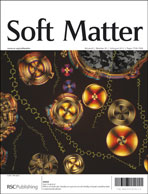We combine large-amplitude oscillatory shear (LAOS) and time-resolved small angle neutron scattering (t-SANS) measurements on the dynamic response of a dispersion of surfactant worm-like micelles. By viewing the response as being the result of a sequence of physical processes, we observe new features of the system response. We identify three distinct frequency regimes including a high frequency Maxwell-like, a yielding, and a settled flow regime. For each regime we identify the molecular origins, on a Kuhn segment scale, of the stress response. We show the ability of the material to ‘over-orient’ pre-yielding, compared with stationary flow. Finally, we present a stress–orientation rule which is rate-based at low frequencies and strain-based at high frequencies.
You have access to this article
 Please wait while we load your content...
Something went wrong. Try again?
Please wait while we load your content...
Something went wrong. Try again?


 Please wait while we load your content...
Please wait while we load your content...